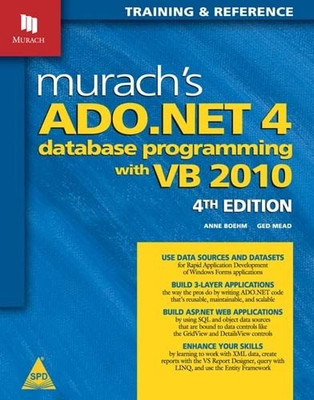Murach's ADO.Net 4 Database Programming with Vb 2010:Training & Refere(English, Hardcover, Boehm Anne)
Quick Overview
Product Price Comparison
If you're going to develop serious database applications in Visual BasicŌĆ”the kind that businesses rely on every dayŌĆ”then this is the book for you. It teaches you how to use Visual Studio 2010 and ADO.NET 4 to develop professional database applications for both Windows and the web as quickly and easily as possible. And it covers the full gamut of skills you need, from using built-in data tools that generate ADO.NET code to writing your own ADO.NET code from scratch so you can closely control how the database processing works: In section 1, you'll get a basic introduction to databases, SQL, and ADO.NET. If you already have ADO.NET experience, you can skip ahead. ┬Ā In section 2, you'll quickly be creating database applications using Rapid Application Development (RAD) tools like data sources. ┬Ā In section 3, you'll build 3-layer applications the way the pros do, with presentation, business, and database classes. This is where you'll get into ADO.NET coding to create your own classes. You'll also learn how to use object data sources to make this approach even more effective. ┬Ā In section 4, you'll develop database applications for the web using ASP.NET 4 data controls like GridView and DetailsView, along with object data sources. ┬Ā In section 5, you'll complete the set of skills that every .NET database programmer should have by learning how to (1) handle XML data in your applications, (2) create reports with Visual Studio's Report Designer and the ReportViewer control, (3) use LINQ to SQL to query datasets and SQL Server databases, and (4) use the Entity Framework and LINQ to Entities to work with database data through an Entity Data Model. The table of contents gives you a complete rundown on what each chapter does. But in brief, by the time you finish this book, you'll have gained the ADO.NET skills that make you a top .NET developer. Try it and see for yourself! About the Author Anne Boehm has over 30 years of experience as an enterprise programmer. She got started with Visual Basic in the days of VB5, and has been programming on .NET since its inception. In the past 5 years, she's added C# to her programming repertoire, and she's authored or co-authored books on Visual Basic, C#, ADO.NET, and ASP.NET. Ged Mead trained in Automatic Data Processing in the early 1980s while in the military. Since those days, he's traveled the world and been involved in a range of IT and developer work. Most recently, he has completed a series of e-learning courses for Windows Forms developers in Visual Basic and C#. He has been awarded Microsoft MVP status for his contributions to the worldwide developer community. Now located in Southwest Scotland, when he's not in his office surrounded by far more computers than one man can possibly need, he can be found walking or cycling in the woodland hills around his home. Table of Contents Section 1. An introduction to ADO.NET programming Chapter 1. An introduction to database programming Chapter 2. An introduction to ADO.NET 4 Section 2. How to use data sources and datasets for Rapid Application Development Chapter 3. How to work with data sources and datasets Chapter 4. How to work with bound controls and parameterized queries Chapter 5. How to use the Dataset Designer Section 3. Three-layer Windows Forms applications Chapter 6. How to work with connections, commands, and data readers Chapter 7. How to work with parameters and stored procedures Chapter 8. How to work with transactions Chapter 9. How to work with object data sources Chapter 10. A complete Payable Entry application Section 4. How to use ADO.NET with web applications Chapter 11. How to use SQL data sources Chapter 12. How to use the GridView control Chapter 13. How to use the DetailsView control Chapter 14. How to use object data sources Section 5. Advanced database programming skills Chapter 15. How to work with XML data Chapter 16. How to use the reporting features of Visual Studio Chapter 17. How to use LINQ Chapter 18. How to use the Entity Framework Resources ┬Ā Appendix A. How to install and use the software and files for this book Index ┬Ā


